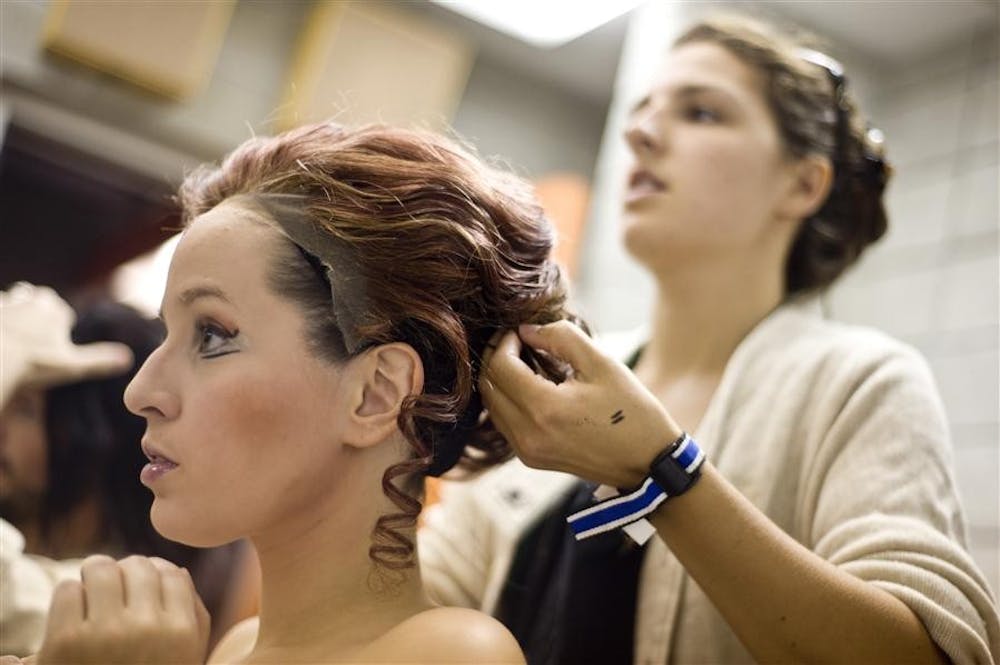The pin is jabbed into her scalp as Angela Kloc flinches in pain.
It’s the last pin needed to transform her naturally straight brown hair and heavy bangs into a mop of copper hair with a low bun.
If she cries it would ruin the make-up applied according to the directions taped on the mirror, and she still needs to get the fake eyelashes glued on.
Two tries later the pin is in, and this is only the first wig of four she’ll wear during the show.
“It’s really weird to get the wig and look at yourself,” graduate student Kloc said, thirty minutes before her call to stage. “You don’t recognize yourself.”
For the next three hours Kloc will be playing Rosina in the Jacobs School of Music’s opera “The Barber of Seville.”
The opera will be at 8 p.m. this weekend and next at the Musical Arts Center. Purchase tickets at the Musical Arts Center box office or by phone, 812-855-7433. Tickets can also be ordered through Ticketmaster by phone or online.
“Rosina is very sassy, feisty, a smart ass in a way. She’s always ahead of the game,” Kloc said. “You want to be like her.”
In the opera, Rosina is under the protection of Doctor Bartolo who wants to marry her for her money. Meanwhile, the Count has fallen in love with Rosina and enlists the help of Figaro, the Barber of Seville, to gain access to her. The love story evolves amidst the comedy and hilarity on stage.
“He gets the girl, I get the gold,” said graduate student Scott Hogsed, who plays Figaro.
The Italian opera is based off the 1775 musical play “Le Barbier de Seville” by Pierre
Beaumarchais.
Despite its old and complex past, the show has a modern feel with a well-known love story, similar to the one in “Sweeney Todd: The Demon Barber of Fleet Street.” The stage is built on a rotating platform, which turns among its three sets.
The opera has a darker, contemporary feel with a Tim Burton influence, said Nic Muni, stage director. He’s also made innovations and taken liberties with the original opera. Dr. Bartolo’s character is made into a mad scientist with a laboratory on stage, Muni said, which is rare to see in most productions.
“It’s a sensory feast,” Muni said.
Conductor Arthur Fagen said the music is stylistically very difficult, but also very familiar for the audience.
“It’s one of the fastest paced operas that ever existed,” Fagen said. “All of the scenic direction and running around is the challenge. And then when the singers are on stage, the difficulties become much more compounded.”
The overture to the show is also used in Looney Tunes for when Elmer Fudd chases Bugs Bunny in the famous episode “Rabbit of Seville.” Most Italian food commercials incorporate the classic “Figaro, Figaro, Figaro” song that Hogsed performs in the first few minutes of the play.
“Everybody knows Figaro, Figaro, Figaro, Figaro!” Hogsed softly sings to reserve his voice. “You just really want that to sparkle.”
To make Figaro sparkle, the cast practices five hours a day during the week and six hours on Saturdays. To make sure their voices stay healthy, there are two casts who rotate performances. However, each show still takes its toll on the performers.
“My shoulders hurt. I bruised my fingernail. I smashed my knee,” Hogsed said. “It’s just one of the most physically demanding shows. I’m just exhausted.”
Kloc echoed his sentiments. She tries to rest her voice as much as possible, even if that includes not hanging out with friends or chatting as much. Instead her attention is focused on eating healthy foods and sleeping.
Now, three days before opening night as Rosina, Kloc only has to live up to her own
expectations.
“Personal expectations are the hardest for me,” she said, applying the last of her make-up before heading on stage. “At the end of the day, you’re the one who has to live with your own performance.”
Opera kicks off 2010-11 season with new production ‘The Barber of Seville’

Get stories like this in your inbox
Subscribe





